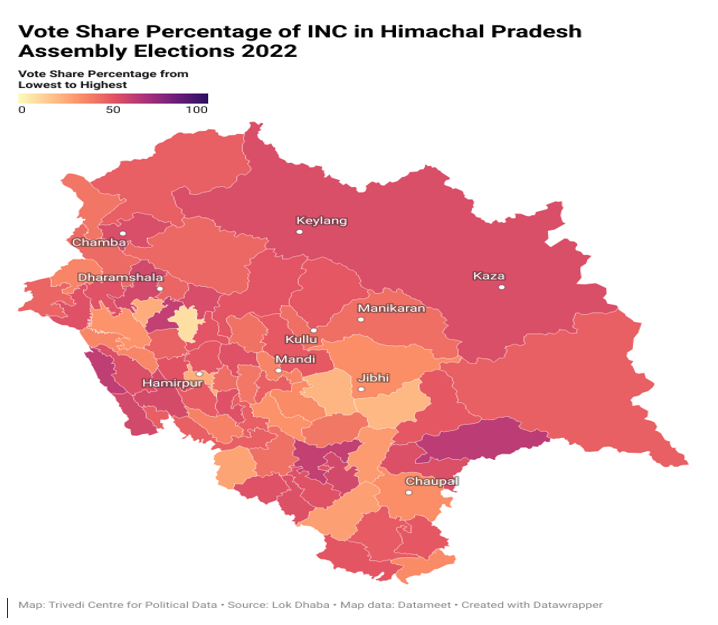One puzzling outcome of the Himachal Pradesh election is the fact that Congress won a comfortable majority of seats with practically the same vote share as BJP (43.9% against 43%). There are only 37974 votes separating the two parties, for a total of 4219635 votes cast. This is the smallest vote share difference between two parties ever recorded in that state. At the constituency level, the average difference in vote share is 1.41%, the lowest since 1951.
This means that despite appearances, this was a very close election. Few number variations here and there could have produced a very different outcome. In this article, we look at the spatial distribution of votes between Congress and BJP, the number of close contests and the possible spoiler effect played by third candidates across the state. Close contest are standardly defined as seats with victory margins inferior to 5% of the votes cast. ‘Spoiler effect’ is marked when the third candidates scores more votes than the difference between winner and runner-up.
A wide distribution of small differences
Maps 1 and 2 show that the votes obtained by Congress and BJP are well distributed. No party dominate any sub-region of the state. Congress candidates were simply ahead of BJP candidates in more seats. Only few candidates won with huge margins, such as Jairam Thakur (BJP), in Sehraj, winning with a 54% margin, or Mohan Lal Brakta (INC), in Rorhu, winning with a 35% margin. In total, 16 candidates out of 68 won with large margins (above 15%), 8 on Congress tickets, 6 on BJP tickets and two independents.

Figure 1. Vote Share% of INC

Figure 2. Vote Share% of BJP
Close contests
There were 20 close contests in Himachal this year, for a total of 68 seats. Suresh Kumar, Congress candidates in Bhoranj, won with a difference of 60 votes. In total, Congress won 12 of these races, against 8 for BJP. Again, tiny number variations across seats would have thrown a very different result. Four seats with a margin inferior to 1% were all won by Congress.
Figure 3 shows the difference in vote share between Congress and BJP candidates (this was calculated by subtracting the vote share of BJP from INC for each assembly). It shows that the distribution of high and low margins between the two parties is wide. Both parties had strong and weak performers. This again confirm that this election wasn’t a landslide for Congress.

Figure 3. Difference in Vote Share% between INC and BJP
Spoiler Effect
Another factor of uncertainty is the presence of spoiler candidates, or candidates winning more votes than the difference of votes between the winner and the runner up. While we cannot ascertain for sure that the third candidate took more votes from the runner-up than the winner, we can hypothesize that their performance affected the outcome in their seat.
We identity 27 seats with possible spoilers. 18 of them are independent candidates. AAP candidates possibly affected the outcome in only two seats, BJP in 3, Congress in one and in two for the Rashtriya Devbhumi Party, a local party. Figure 4 shows the spatial distribution of spoiler candidates, more concentrated in Southern districts and in urban seats.

Figure 4. Spoiler Effect in Himachal Pradesh
Turncoats and rebels did not play much role in this election. There are only 12 turncoat candidates and only four of them came from Congress and BJP (two each). Paramjit Singh, a BJP rebel in Doon, is the only major party turncoat to have won, as an independent candidate.
These numbers illustrate how small number variations in Indian elections can make large differences. Congress doubles its seat share by only gaining 2.2% vote share, compared to 2017. BJP lost 5% of its votes and 19 of the 44 seats it had five years ago. This suggests that Congress did not manage to swing a lot of voters from the BJP and that the votes gained by independent candidates and small parties candidates made a difference in many constituencies.
These numbers also show how AAP completely failed to make an imprint in Himachal Pradesh. Their vote share is insignificant (1.2%) and their candidates have only possibly affected outcomes in two seats.
These results point towards the importance of individual candidates in Himachal Pradesh. Contrary to BJP’s claims that ‘candidates don’t matter’, individuals clearly determined the outcome. All the Prime Minister’s visits and gestures towards the state over the past few months were insufficient to compensate for the state of internal division in the BJP and for the resulting party’s disorganization.
About the Authors
Gilles Verniers is Director, TCPD and Assistant Professor of Political Science, Ashoka University.
Poulomi Ghosh is a Research Fellow at Trivedi Centre for Political Data, Ashoka University
Ananay Agarwal is the Research lead at Trivedi Centre for Political Data, Ashoka University
Disclaimer
This article belongs to the author and is independent of the views of the Centre.

